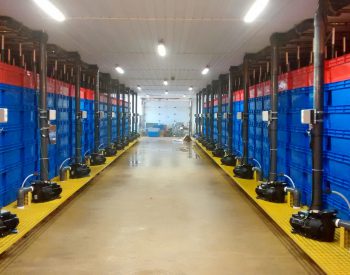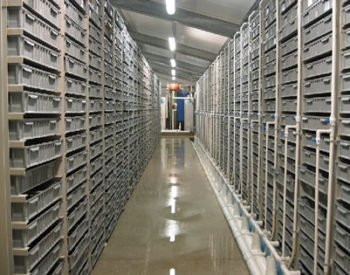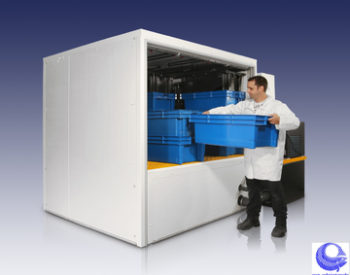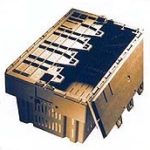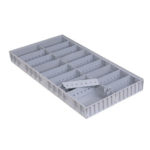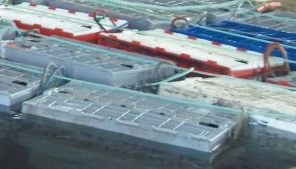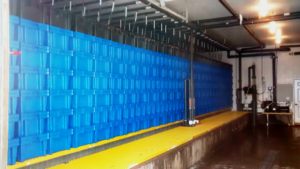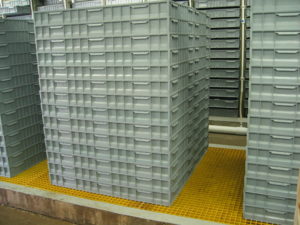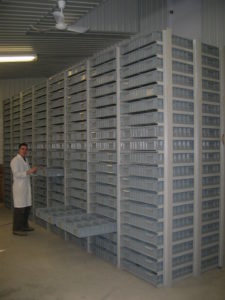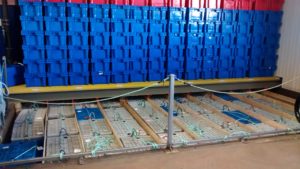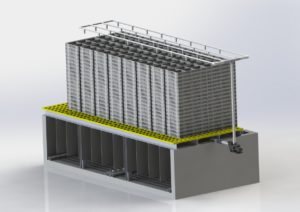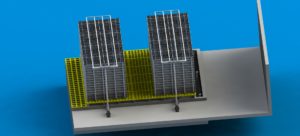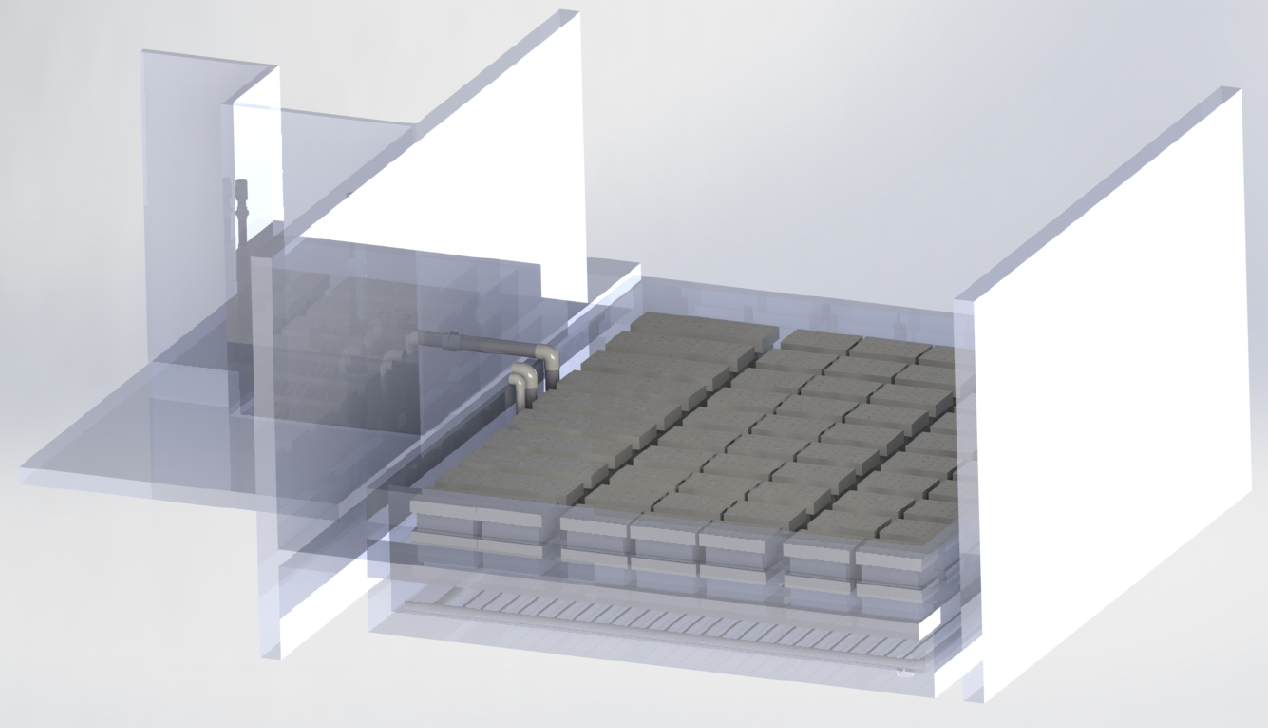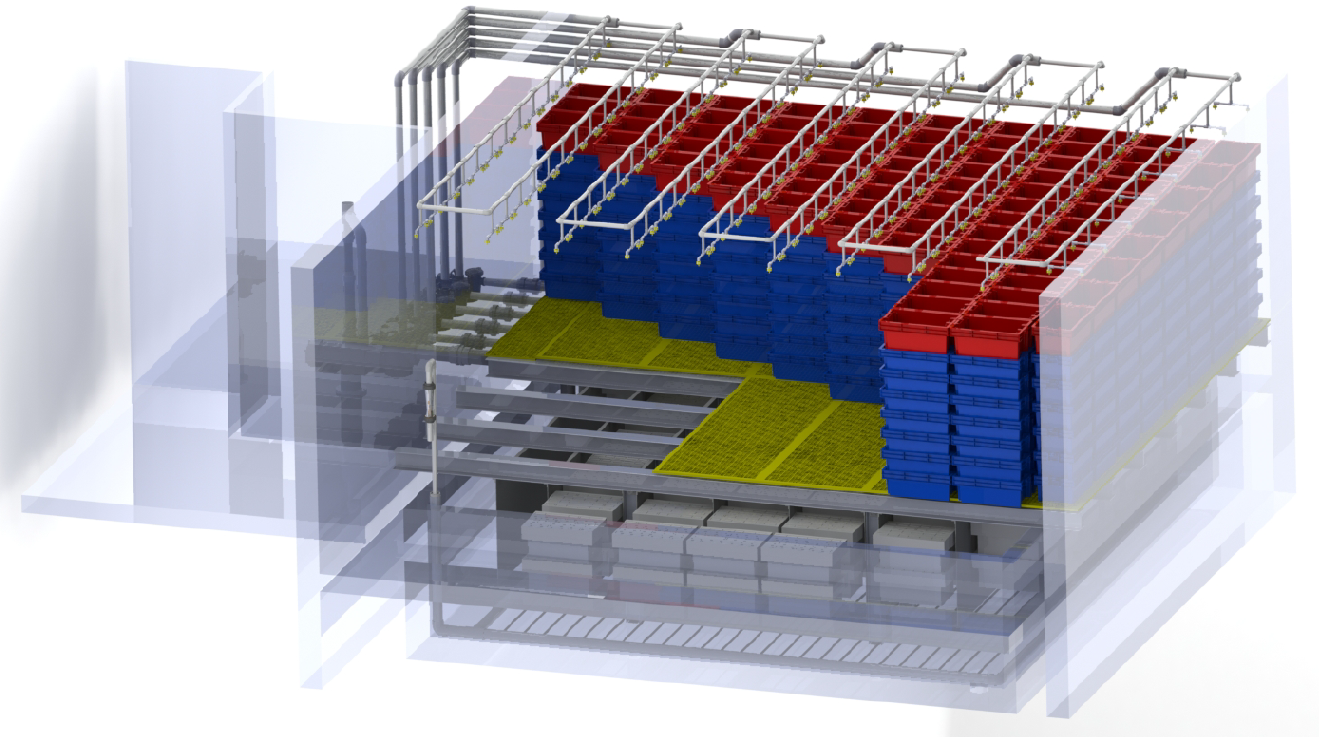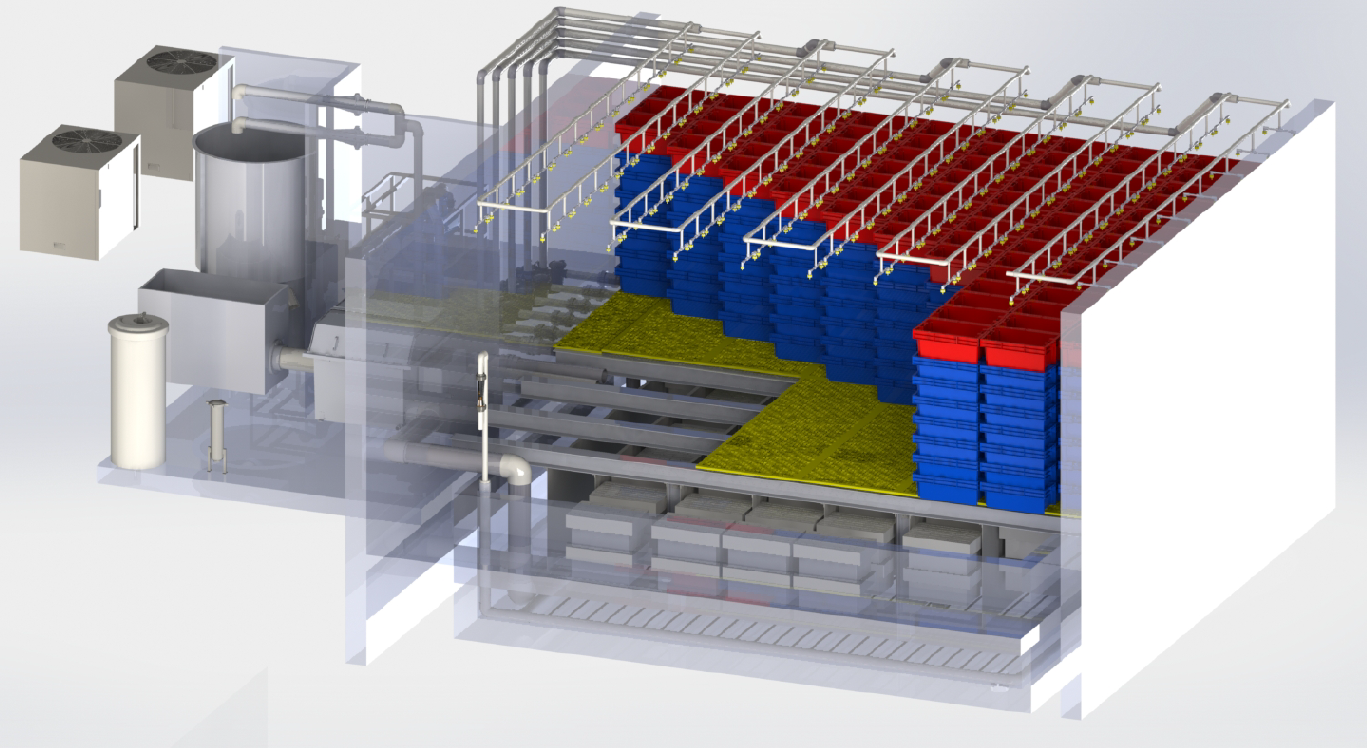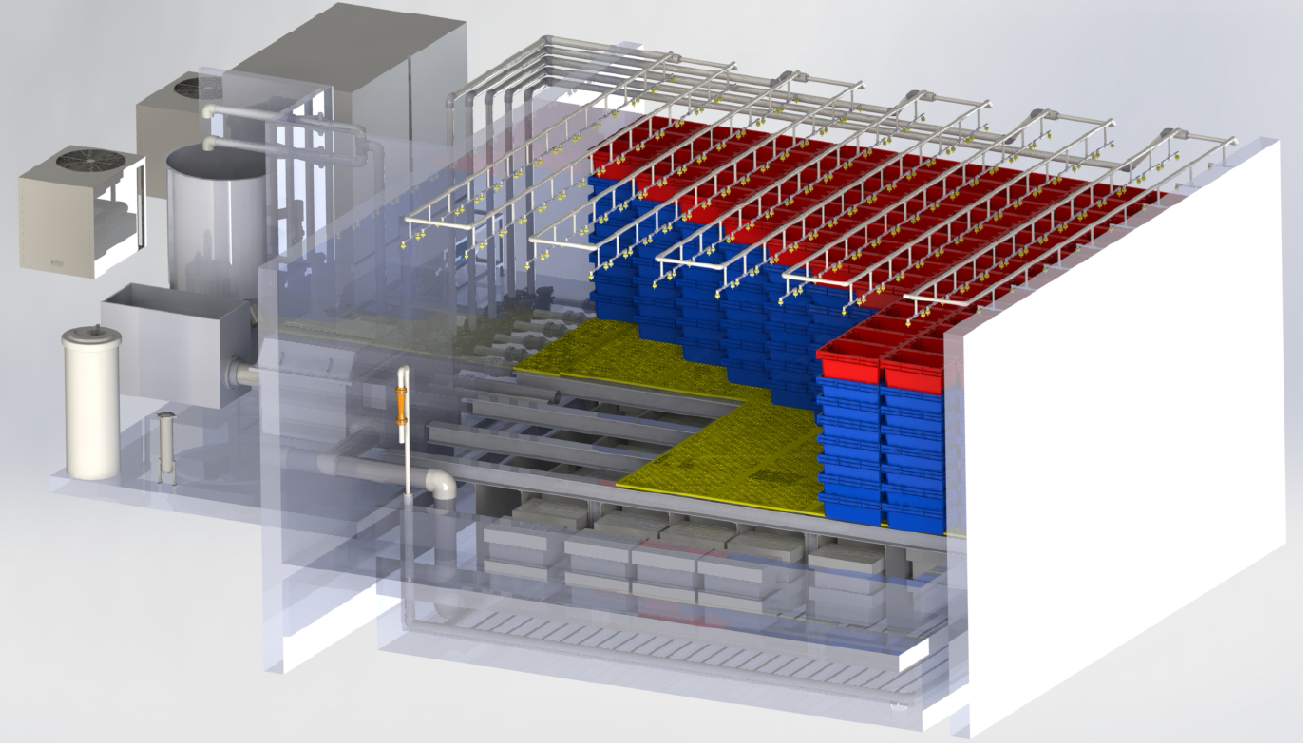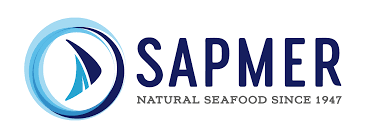Eco Lobster-Condo
Discover Vertical Storage
CANADIAN TECHNOLOGICAL KNOW-HOW
“If you can keep pure, well oxygenated water flowing around each of the animals, they’re going to live much longer.” _ Words of wisdom from Canadian biologist Hélène Drouin, president of AQUABIOTECH INC, and specialist in the design and fabrication of closed-circuit tanks for the conservation of aquatic and marine life. “Furthermore, if you keep each animal segregated in chilled water, you can store quality lobster for at least three months, and possibly up to six months.”
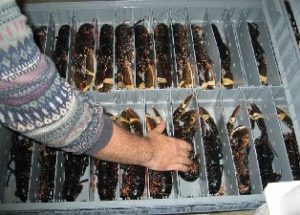
Eco Lobster-Condo
- More pounds per square foot
- Healthy lobster with zero mortality
- Quality lobsters stay alive for up to six months
Traditionally, lobster purging and refreshing is done in crates flowing into the lobster pond.
«However by adding vertically stacked totes over a lobster pond, the storage capacity of a pond will double. This allows for a huge saving in land and building space.»
With our mix of purging and long-term storage systems you are sure to keep you clients happy with quality product: an investment that rapidly pays for itself. Our experienced team of biologists, engineers and technicians is well equipped to take your project from concept, whether a new or upgraded facility, through successful implementation.
A thoughtful design that translates into a better use of energy, space and water.
ECO LOBSTER-CONDO: A SUREFIRE UNION OF COMMON SENSE WITH TECHNOLOGY
The ingenious design enables you to store lobster with ease in a surprisingly small footprint, while oxygen-laden water flows around each animal.
3 applications: 3 Eco Lobster-Condo systems
Eco Lobster-Condo is AQUABIOTECH’s exclusive line of equipment for the storage of live crustaceans.
Most Lobster Condos are chilled lobster holding systems for either long-term storage (several months of storage, no feeding), or In-Out operation (transit systems). Many are compact shower systems. Some operate with conventional tanks.
“Transit” and Long-term holding systems can be located away from shore. About 99.9% of the water flowing through them is then recycled to reduce water replacement and chilling costs to its minimum. Partial water reuse is applied for near-shore plants that benefit from clean seawater.
We also upgrade existing purging ponds to double their holding capacity. Trays or totes are then stacked over the pond and connected to our water recycling/chilling system. The pond becomes a chilled storage system able to hold product beyond the fishing season.
Whether your future system is partly recycled without biofiltration or a REBF system (water Recycling with BioFiltration) system, we guaranty the quality of the water in it. Plus, all its parameters, whether they are temperature, oxygen, ammonia, CO2, salinity, and pH, can be monitored.
White Paper
System components
Holding Tanks
Holding Tanks Layout
Hydraulics options
In North America, because of its buoyant ring around the collar, plastic floating crates have replaced wooden crates. They are the preferred way of carrying lobsters to the indoor lobster tank into which they are floated. Seasoned lobster is then shipped directly from the lobster tank to the clients.
- Max: 100 lbs.
- For disgorging & transport
Built with stand pipes, and combined with a series of calibrated holes, these cost-effective totes keep lobster submerged in a constant flow of water. Stacked 3 to 6 high, depending on water temperature, they are ideal to keep lobster short term in a small foot print.
- Dimensions (ext): 31.7’’x 18.3’’x12.9’’H.
- Integrated overflows keep submerged lobster.
- Place under shower.
- 55 lb / tote.
- For disgorging *
* Totes can keep lobster medium-term if compartmentalized.
Shallow basin made of moulded plastic with a built-in overflow that spills water from one level of tray down to the next. Each pull-out tray consists of 6 permanent sections into which dividers can be placed so as to keep the animals apart. Trays can be either pulled out like drawers from a cabinet, or nested into stacks.
Lobster trays were developed to meet longer-term holding requirements faced by lobster distributors to balance seasonal harvests with market demands. Combined with our aquaBiota water reused systems, they provide optimum conditions for the lobster to survive and thrive in storage.
- Dimensions (ext): 48.3’’ long x 28.2’’ wide x 4.9’’ deep.
- Integrated overflow keeps submerged lobster.
- Placed under shower or rigged in pool.
- Can house between 18 to 36 lobsters, depending on their size
- Total capacity between 32-45 lbs / tray.
- Contention extended
Specifications:
- Site: near the ocean where the system is operating in a flow-through basis without temperature control.
- Purpose: lobster disgorging (a few days to clean intestines).
- Type of holding tank: concrete tank.
- Type of layout: floating crates.
- Water treatment #1: water inlet degassing to remove supersaturation, if required.
- Water treatment #2: aeration to provide oxygen to lobster.
- Water treatment #3: automatic water oxygenation by injecting pure oxygen during periods of loading of the pool – See the before/after graph!.
- Water treatment #4: water swirling to make the pool self-cleaning.
The hydraulics of these systems is controlled by the injection of air, oxygen, and water in order to create a totally mixed pool with optimal uniform quality, allowing them to:
- Eliminate or reduce fluctuations in dissolved oxygen between day and night and during periods of loading of the pool.
- Allow an increased supply of oxygen at high water temperatures at the end of the season.
- Improve the diffusion of dissolved oxygen inside floating crate.
Specifications:
- Site: near the ocean where the system is operating in a flow-through basis without temperature control. The pool water is reused to supply showers.
- Purpose: lobster disgorging & short-term holding (1 to 2 weeks)
- Type of holding tank: crates & totes.
- Type of layout: floating crates and totes under shower.
- Water treatment #1: water inlet degassing to remove sursaturation.
- Water treatment #2: aeration for increase and stabilize the level of dissolved oxygen in the water of the pool.
- Water treatment #3: water oxygenation by injecting pure oxygen during periods of loading of the pool.
- Water treatment #4: water swirling to make the pool self-cleaning.
- Water treatment #5: pool water pumping to showers.
Specifications:
- Site: near the ocean. The pool water is reused for temperature control. The fresh seawater inlet is only for controlled the level of ammonia.
- Purpose: lobster disgorging & middle-term holding (1 to 2 months)
- Type of holding tank: crates, totes & trays.
- Type of layout: floating crates, totes and /or trays under shower.
- Water treatment #1: water inlet degassing to remove sursaturation.
- Water treatment #2: aeration for increase and stabilize the level of dissolved oxygen in the water of the pool.
- Water treatment #3: water oxygenation by injecting pure oxygen during periods of loading of the pool.
- Water treatment #4: water swirling to make the pool self-cleaning.
- Water treatment #5: pool water pumping to showers.
- Water treatment #6: chilling.
- Water treatment #7: drum filtering (only if you degorging lobster in the pool).
Specifications:
- Site: For a site away from the ocean, water is 100% recycled, or very close to it. This high level of water reuse opens up a leeway for temperature control. The chilling energy is solely used for neutralizing heat gains from the pumps, air, and the surfaces (walls, ceilings, ground).
- Purpose: lobster disgorging & long-term holding (up to 6 months)
- Type of holding tank: best done with trays. These may be set on the floor or over a pool.
- Type of layout: trays under shower – nested or in cabinet-like shelving
- Water treatment #1: water inlet degassing to remove sursaturation.
- Water treatment #2: aeration for increase and stabilize the level of dissolved oxygen.
- Water treatment #3: water swirling to make the pool self-cleaning, if a pool is present.
- Water treatment #4: water pumping to showers.
- Water treatment #5: water chilling
- Water treatment #6: water filtration for solid removal
- Water treatment #7: biofiltration;
- Water treatment #8: pH stabilisation and fine organics removal.
A Closed-System implies a complete water recycling system. Some call it a RAS (Recirculating aquaculture system). We call it a REBF (recycling with biofiltration) system.
Unique in the industry, our AquaNit trickling biofilters are pre-coated with active saltwater nitrifying bacteria before adding lobster. This cuts months of biofilter maturation and significantly reduces initial ammonia spikes. A Biofilter Inoculation Station (BIS), available for renting or purchase, making this process easy and automatic.




